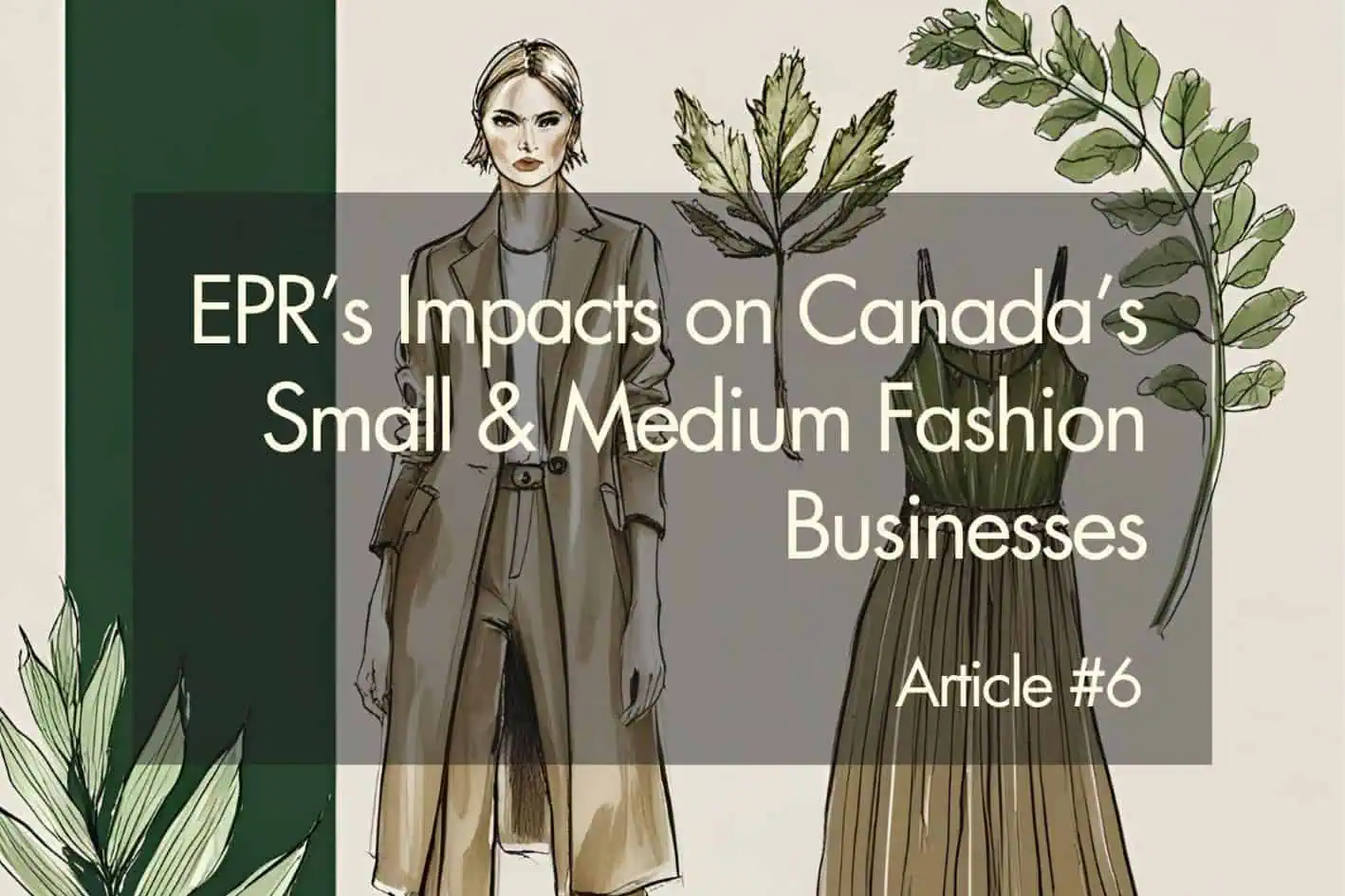The Hidden Costs of Fashion: How Increased Demand and Production Exploit Marginalized Communities in Developing Countries
-
Deborah King
- Fashion, Sustainability

Abstract
The global fast fashion industry has exacerbated labor exploitation and environmental degradation, particularly in developing nations. As demand for affordable, mass-produced clothing has surged, inadequate regulatory oversight has enabled the exploitation of marginalized communities. Simultaneously, the resulting textile waste and pollution have wreaked havoc on ecosystems. Tracing the evolution of the fashion industry from its origins in regulated guild systems to its current globalized model reveals how these shifts have facilitated power imbalances, allowing firms in Western countries to extract value from labor and resources in developing nations. The environmental consequences, including water contamination and the destruction of local ecosystems, disproportionately affect vulnerable populations, yet the impacts are becoming increasingly global as climate change and water scarcity intensify. The future of the fashion industry requires rethinking how ethical and sustainable practices can be implemented in an interconnected world driven by rapid production and consumption.
Table of Contents
1.1 Evolution of the Fashion Industry and Women’s Rights
1.2 Role of Synthetic Fibers
1.3 Shift to Offshore Production
1.4 Rise of Fast Fashion
1.5 Fast Fashion Profits and Valuation
1.6 Average Salary of Garment Workers
2.0 Labor Exploitation in Marginalized Communities
2.1 Women in the Fashion Supply Chain
2.2 Forced Labor in the Fashion Supply Chain
2.3 Impacts to Garment Workers
3.0 Environmental Injustice in Marginalized Communities
3.1 Water Scarcity
3.2 Water Consumption in Growing Cotton – Current and Future Projections
3.3 Pesticides and Their Impacts
3.4 Impacts of Cotton Dyeing and Chemical Treatments
3.5 Diversion from Food Crops
3.6 Global Scale of Water Usage
3.7 Textile Waste
4.0 Conclusion
1.0 The Transformation of the Fashion Industry from Regulated Trade to Globalized Production
1.1 Evolution of the Fashion Industry and Women’s Rights
Fashion was a regulated trade when it emerged in Europe during the Middle Ages (Ford, 2021). To practice legally, one had to belong to a guild, with specific ones for tailors, weavers, embroiderers, and furriers—each exclusively male (Ford, 2021). These guilds operated within a hierarchical structure, comprising masters, journeymen, and apprentices. Apprentices trained for years under a master before advancing to the journeyman level (Ford, 2021). The guilds set quality standards for workmanship and materials, regulated prices, and maintained control over working conditions and competition within the trade (Ford, 2021).
By the 19th century, the “modern fashion system” evolved and shifted away from the guild structure (Ford, 2021). This was largely influenced by the invention of the modern sewing machine by Isaac Singer in the early 1850s, which made sewing more accessible to women (Ketteler, 2010). Paper patterns were also introduced around this time, making European fashions available to North American audiences (Hunter, 2020).
In the 1920s, the Great Depression further propelled home sewing, as a way to save money and mend clothes. Women became more accepted in the trade around World War II when efforts were needed to sew uniforms and other items for the military (National WWII Museum, n.d.; Ford, 2021). This wartime experience contributed to the changing attitudes that would later influence the Women’s Rights movement of the 1960s (National WWII Museum, n.d.; Ford, 2021).
1.2 Role of Synthetic Fibers
Before the introduction of synthetic fibers, there were strong class distinctions in fashion, with sumptuary laws restricting certain fabrics, styles, and colors to specific social classes (Ford, 2021). Wearing clothing “above one’s station” could be viewed as presumptuous or inappropriate (Ford, 2021). Upper classes had access to expensive, high-quality fabrics like silk, fine wool, and imported cotton (Ford, 2021). In contrast, lower classes typically wore garments made from coarse, low-grade wool, rough linen, and untreated cotton (Ford, 2021).
The introduction of nylon in 1938 transformed the textile industry by providing a more accessible and affordable alternative to silk, which was regarded as a luxury material (Kativa, 2016; Ford, 2021). By the 1950s and 1960s, synthetic fibers such as nylon, polyester, and acrylic had become common in everyday clothing (Kativa, 2016). During this time, ready-to-wear fashion became more accessible to middle- and working-class consumers (Ford, 2021). This increased availability of clothing also played a role in women’s participation in the workforce, as they were able to “dress the part” (Ford, 2021).
1.3 Shift to Offshore Production
Following World War II, an economic boom led to a surge in demand for fashion, with disposable income rising by 43% in the 1950s and 37% in the 1960s (Statistics Canada, n.d.). As labor costs increased in industrialized nations, the fashion industry began exploring offshore production opportunities (INDEX, n.d.).
Globalization further intensified competition among apparel manufacturers, prompting the opening of textile mills in developing countries during the 1960s and 1970s. These mills could produce clothing faster and more economically to meet growing demand (Sierra, 2023). By outsourcing production to regions such as South America, Central America, and East Asia, the industry could take advantage of lower costs (Ford, 2021).
Trade liberalization in the late 20th century allowed Western countries to source cheaper apparel from developing regions (Wyman, 2006). The gradual reduction of quotas and tariffs on textiles and apparel, particularly through commitments under the World Trade Organization (WTO), led to an influx of imported goods (Wyman, 2006).
1.4 Rise of Fast Fashion
With access to cheaper overseas production, manufacturers significantly increased clothing output. Between 2000 and 2014, global clothing production nearly doubled, surpassing 100 billion garments annually (FashionUnited, n.d.; Remy et al., 2016; McFall-Johnsen, 2020). This surge in production coincided with a shift in consumer purchasing habits, with reports indicating that people bought 60% more garments in 2014 compared to 2000 (Remy et al., 2016; McFall-Johnsen, 2020). This rapid production model gave rise to “fast fashion,” defined by quick and inexpensive clothing production (Hayes, 2024).
As clothing became more affordable, fast fashion retailers and e-commerce platforms made it increasingly accessible, allowing consumers to purchase trendy items with ease. Beyond affordability and convenience, other key drivers of consumer behavior included celebrity culture and the growing influence of social media. Celebrity endorsements or appearances often led to immediate surges in sales. For instance, in early 2024, Levi Strauss & Co. experienced a 20% increase in store visits and a corresponding rise in stock prices after Beyoncé referenced “denim on denim” in a song (Shah, 2024).
Platforms like Instagram, TikTok, and Twitter gave celebrities unparalleled access to vast audiences, enabling them to instantly promote products (Graham, 2020; Grybauskaite, 2024). The visual appeal of these platforms meant that a single post showcasing an outfit or accessory could quickly capture attention and boost sales. For instance, after Taylor Swift was posted with a Stella McCartney bag at Coachella, consumer interest in the brand surged by 75% (Grybauskaite, 2024). Similarly, influencers capitalized on social media by sharing “hauls” with incentivized links to fast fashion brands, generating additional income through these promotions.
The portrayal of idealized lifestyles by celebrities and influencers often pressures consumers to conform to certain beauty and fashion standards (Graham, 2020). As individuals try to keep up with trends set by their favorite stars, they may feel compelled to make more purchases to fit in (Graham, 2020).

1.5 Fast Fashion Profits and Valuation
In 2023, the fast fashion market was valued at approximately USD 100 billion, with projections suggesting it could grow to USD 180 billion by 2030 (Precision Business Insights, n.d.; Zion Market Research, n.d.). Leading fast fashion brands generate revenues surpassing the GDP of entire nations, enriching their predominantly male founders and CEOs.
For example, Inditex Group, the parent company of Zara, reported a revenue of around USD 39.4 billion in 2023, with its founder, Amancio Ortega, holding a net worth of over USD 90 billion. Similarly, in 2023, Shein generated an estimated USD 32.5 billion in revenue, with its founder, Xu Yangtian, possessing a net worth between USD 11.2 and 21.5 billion (PressFarm, 2024; McLaughlin, 2024). H&M Group’s revenue for the same year was around USD 22.7 billion, with founder Stefan Persson’s net worth at USD 18.2 billion (H&M Group, 2024).
This concentration of wealth illustrates the centralization of financial power within the fast fashion industry, with many of these founders ranked among the world’s wealthiest individuals.
1.6 Average Salary of Garment Workers
In stark contrast to the vast revenues and net worths of fast fashion companies, the average wages of the workers who produce their clothing remain alarmingly low.
Wages vary significantly by country. For instance, in 2018, the average monthly wage for a garment worker was approximately USD 95 in Bangladesh, USD 170 in Cambodia, and USD 420 in China (van Klaveren & TIjdens, 2018). There are also gender disparities; in 2019, male garment workers in India earned an average of USD 162.23 per month, while female workers earned around USD 113.69 (Anner & Dutta, 2019).
Many garment workers, especially in countries like India and Bangladesh, are also employed as contract labor through third-party arrangements rather than being directly employed by factories (Chan, 2013). These workers often receive lower wages, with some earning as little as USD 70-80 per month (Chan, 2013). Additionally, they face deductions from their pay for accommodations and transportation, further reducing their already low earnings (Chan, 2013).
The COVID-19 pandemic worsened wage disparities for garment workers. In Bangladesh, for example, workers saw a 21% reduction in wages during the crisis, leaving many unable to meet their basic needs and leading to widespread hunger (Kyritsis et al., 2020).
Wage inequality is not limited to developing countries. In Leicester, UK, some garment workers earned as little as £3 per hour during the pandemic, far below the legal minimum wage (Bland & Campbell, 2020). Many of these workers, predominantly immigrants, faced unsafe working conditions, with some factories disregarding lockdown rules and safety protocols (Bland & Campbell, 2020).
Garment workers typically earn wages below the standard needed to cover basic necessities such as food, housing, and healthcare (van Klaveren & Tijdens, 2018). Meanwhile, top executives at fast fashion companies accumulate more income in mere seconds than many of these workers make in a year (Anner & Dutta, 2019). This extreme inequality underscores broader concerns about exploitative labor practices and the difficult conditions faced by these workers.
2.0 Labor Exploitation in Marginalized Communities
2.1 Women in the Fashion Supply Chain
Despite earning wages far below a living standard, women and informal labor form the backbone of the garment industry’s workforce. This dependence underscores the deep intersection of gender and economic exploitation within the sector.
Women constitute around 75% of the global garment workforce, with rates reaching 60-80% in countries like Bangladesh and India (Chan, 2013; Tager, 2016). The industry’s heavy reliance on informal labor further marginalizes the workforce, especially in developing countries, where 60-70% of workers are employed under informal or contract-based arrangements (Chan, 2013; Tager, 2016). These informal workers, primarily women, face additional challenges due to their status as both women and precarious laborers, making them particularly vulnerable to exploitation.
The lack of regulation in informal labor allows factories to circumvent legal protections, such as minimum wage requirements and labor rights (Chan, 2013). As a result, these workers, who are disproportionately female, experience heightened levels of exploitation, with no job security or formal protections (Chan, 2013).
Child labor is also prevalent in these informal, unregulated settings, particularly in South Asia (Chan, 2013). While the exact number of children involved in garment production is not known, it is estimated that over 100 million children work in hazardous conditions throughout the global garment supply chain (Ludmer et al, 2023; Clean Clothes Campaign, n.d.). Economic hardships in developing nations force many families to rely on their children’s income (Helm, 2024).

2.2 Forced Labor in the Fashion Supply Chain
Forced labor, or modern slavery, is a significant and deeply troubling issue within the fashion supply chain, especially in developing countries. It is estimated that 29.8 million people are trapped in modern slavery conditions globally, where individuals are often coerced into working against their will through threats or deception (International Labour Organization, n.d.; Crimestoppers UK., n.d.; Walk Free, n.d.).
Several factors make individuals vulnerable to forced labor including the following:
a) Deceptive Recruitment Practices:
• Deceptive Recruitment Practices: Recruitment agencies and intermediaries often entice workers with promises of fair wages and decent working conditions. However, once they arrive at the factories, workers frequently encounter hazardous environments, long working hours, insufficient pay, and restricted freedom to leave (LeBaron et al., 2018).
• Debt Bondage: Many workers are forced to take on debt from their employers before they even start working, using loans to cover basic necessities like food, housing, and healthcare. Employers then exploit this financial dependency, trapping workers in a cycle of debt repayment and requiring them to live in employer-controlled facilities. As they work for little or no pay, the debt often increases due to unfair deductions or inflated interest rates, leaving workers with few options to escape these exploitative conditions (LeBaron et al., 2018)
b) Coercion and Exploitation:
• Passport Confiscation: Employers or recruiters, especially when dealing with migrant workers, often confiscate workers’ passports. This leaves workers powerless to leave or seek help, as they lack the legal documentation needed to return home or find other employment (LeBaron et al., 2018).
• Threats and Intimidation: Workers often face physical and psychological threats from factory supervisors, including the risk of violence, deportation, or job loss if they fail to meet production targets. In extreme cases, workers may be physically restrained or isolated (LeBaron et al., 2018).
c) Economic Vulnerability:
• Poverty and Economic Necessity: Extreme poverty and limited job opportunities drive many individuals into forced labor. In developing countries, where the garment industry is often one of the few available job options, workers endure exploitative conditions because they have no other choice. Their financial vulnerability makes them easy targets for coercion and exploitation (LeBaron et al., 2018).
• Reliance on Informal Employment: Informal labor offers little to no legal protection, leaving workers without formal contracts unable to assert their rights or access benefits. This lack of official employment status makes them highly vulnerable to forced labor and exploitation, with limited legal recourse (LeBaron et al., 2018).
d) Supply Chain Fragmentation:
• Fragmented Supply Chains: The fashion industry frequently outsources production to multiple tiers of contractors and subcontractors, often in regions with weak or poorly enforced labor laws. These additional layers make it challenging to monitor and regulate labor practices throughout the supply chain, allowing forced labor to occur (LeBaron et al., 2018).
• Pressure from Western Brands: Western fashion brands often impose tight deadlines and demand low-cost production from suppliers. This pressure leads production facilities to cut corners and resort to exploitative labor practices, such as forced overtime and abusive working conditions (LeBaron et al., 2018).
e) Weak Regulatory Enforcement:
• Lack of Government Oversight: In many garment-producing countries, labor laws are often ignored or poorly enforced. This creates conditions where corruption and exploitative practices can thrive, with factory owners and intermediaries facing little fear of legal consequences (LeBaron et al., 2018).
Statistically, women and girls are disproportionately vulnerable to modern slavery within the garment industry. In 2016, it was estimated that globally 71% of individuals in modern slavery were female (Bryant & Joudo, 2021). This includes adolescent girls, who are often targeted due to their gender and age, making them particularly susceptible to forced labor in informal sectors such as garment production (Bryant & Joudo, 2021). Women are also overrepresented in unregulated, informal work environments, including home-based garment production, where they face exploitation, including long hours, low wages, and abuse from employers (Bryant & Joudo, 2021).
Forced child labor is also widespread in the fashion industry, especially in developing countries (James, 2022). Children are often used in tasks like cotton picking, yarn spinning, and garment sewing (James, 2022). The industry’s demand for cheap labor fuels a cycle of exploitation, where children are preferred for tasks requiring “small fingers,” which are seen as ideal for detailed work (James, 2022).
Countries with significant cotton and garment production, such as China, India, Bangladesh, Uzbekistan, and Turkmenistan, are hotspots for forced labor practices (Murphy et al., 2021). Since 2017, the Chinese government has detained as many as 1.8 million Uyghur, Kazakh, and other ethnic minorities in Xinjiang, subjecting them to “re-education” camps and forced labor programs (Murphy et al., 2021). Many of these individuals are coerced into working in the cotton and textile industries (Murphy et al., 2021). Xinjiang, which produces approximately 85% of China’s cotton and 22% of the world’s cotton, relies heavily on forced labor, with much of the cotton hand-picked by Uyghur minorities under state-sponsored programs (Murphy et al., 2021).
Tracing Xinjiang-grown cotton is particularly challenging, as it is often laundered through international supply chains (Murphy et al., 2021). This cotton is exported to intermediary countries such as Bangladesh, Vietnam, and Indonesia, where it is processed into textiles, effectively obscuring its origin before reaching global markets (Murphy et al., 2021).

2.3 Impacts to Garment Workers
The exploitation of marginalized populations in the fashion industry strips people of their basic human rights and dignity. These widespread abuses lead to a host of serious problems for these vulnerable groups, including the following:
a) Trapped in a Cycle of Poverty
Workers, especially women and migrants, are often forced to rely on exploitative jobs because they have no other options. They’re paid wages that barely cover basic living expenses, forced to work excessive hours, denied fundamental rights, and subjected to unsafe conditions. This lack of viable alternatives keeps them trapped in a cycle of poverty, without the means or resources to improve their situation (Foote, 1994).
b) Lack of Education for Children
In situations of poverty, some families choose to send their children to work instead of school (Lau & Chan, 2021). Girls are especially likely to be pulled from education to work in the garment industry (Radhakrishnan, 2015). This further perpetuates the cycle of poverty, as child laborers grow up without an education, limiting them to low-paying jobs in adulthood (Radhakrishnan, 2015).
c) Harassment and Gender-based Violence
Many women working in garment factories are subjected to “quid pro quo” sexual harassment, where supervisors or managers demand sexual favors in exchange for better working conditions or overtime opportunities (Simmons, 2020). Often, they have no real choice and face abuse if they refuse (Simmons, 2020). The persistence of gender-based violence in the workplace is fueled by weak enforcement of labor laws and the lack of effective policies to prevent harassment. This issue is particularly pronounced in Southeast Asia, where patriarchal norms further exacerbate the problem (Simmons, 2020; Ünlütürk & Öngel, 2023). In instances where workers have attempted to unionize and advocate for their rights, both they and their families have been subjected to violence, and in extreme cases, even death (Kent, 2023).
d) Health and Safety Risks in Production
Fashion supply chain workers often lack proper safety training and are not equipped with personal protective equipment (PPE). The absence of these safety measures, coupled with exploitative labor practices, contributes to the risk of workplace accidents and chronic health problems (Malik et al., 2010). Inadequate ventilation exposes workers to cotton dust and synthetic particles, which can lead to respiratory issues (Bick et al., 2018). Prolonged exposure can result in severe lung conditions such as asthma and byssinosis (Ahmad et al., 2020). Additionally, noise levels in these environments often exceed safe limits, contributing to hearing impairments (Ahmad et al., 2020). A study found that 67% of textile workers in Pakistan experienced respiratory problems due to dust exposure, while nearly 16% suffered from noise-induced hearing loss (Ahmad et al., 2020).
Garment workers often experience musculoskeletal disorders, due to working long hours in poorly designed ergonomic environments (Asare et al., 2019). Inadequate lighting for repetitive tasks also contributes to eye strain and fatigue. Moreover, many workers are exposed to harmful chemicals used in dyeing and finishing processes without adequate protective equipment (Raigrodski, 2016). These chemicals pose significant health risks, causing skin irritation and respiratory issues. Female workers are particularly vulnerable, facing additional challenges like reproductive health problems linked to toxic chemical exposure (Ahmad et al., 2020; Akhter, 2010). The physically demanding nature of the work is further evidenced by frequent reports of fainting and exhaustion (Akhter, 2010).
e) Facility Safety
Many garment factories lack adequate emergency plans, with issues such as blocked exits, the absence of fire extinguishers, and insufficient worker training on evacuation procedures (Wiersma, 2018). These shortcomings create life-threatening situations when fires break out, leaving workers trapped in dangerous conditions (Clean Clothes Campaign, 2022).
A stark example is the collapse of the Rana Plaza factory in April 2013, the deadliest garment factory disaster in history, which claimed over 1,100 lives and left more than 2,600 injured (Global Measure Inc., 2022). The tragedy revealed severe flaws in building safety, labor rights, and supply chain accountability within the fashion industry (Global Measure Inc., 2022). The eight-story building, constructed on unstable ground using substandard materials, had visible structural damage before the collapse (Global Measure Inc., 2022). Despite the apparent cracks, workers were coerced into returning to work under the threat of losing their wages (Global Measure Inc., 2022).
Although initiatives like the Accord on Fire and Building Safety have aimed to improve worker safety, significant issues remain (Global Measure Inc., 2022). Reports regarding unsafe working conditions continue to surface, including ongoing fire hazards and inadequate building safety measures. Since the Rana Plaza disaster, several fatal factory fires have occurred in developing countries, underscoring the continued risks within the industry (Global Measure Inc., 2022).
f) Psychological Repercussions
The psychological impact on child laborers can be profound, as they endure not only physical exhaustion but also the stress and demands of their harsh work environments. Exposure to hazardous conditions, physical punishment, and verbal abuse often lead to significant psychological distress, including trauma (Lau & Chan, 2021). Children forced to work long hours under exploitative conditions are particularly vulnerable to developing anxiety, depression, and low self-esteem (Lau & Chan, 2021).
3.0 Environmental Injustice in Marginalized Communities
3.1 Water Scarcity
In addition to labor exploitation, marginalized communities face severe environmental injustices within the fashion supply chain, with water scarcity being one of the most urgent challenges (Padder & Bashir, 2023). Climate change has reduced the availability of potable water, while other factors have increased demand for these already limited resources (Padder & Bashir, 2023). This issue is particularly acute in developing nations, where marginalized populations struggle with scarce access to clean, safe water and lack the infrastructure to adapt to changing water conditions (Padder & Bashir, 2023). The fashion industry exacerbates this problem, as the cultivation of raw materials like cotton places immense pressure on water resources.
3.2 Water Consumption in Growing Cotton – Current and Future Projections
Cotton is one of the most widely used textiles in the fashion industry. It is also one of the most water-intensive crops to cultivate. The amount of water required varies based on factors such as soil composition, climate, and geographic location. In arid regions, cotton farming places a heavy demand on freshwater resources, as irrigation is crucial for sustaining the crop (Jans et al., 2021).
A notable example of the environmental impact of cotton cultivation is the drastic shrinkage of the Aral Sea, once the world’s fourth-largest inland sea (Gaybullaev, 2009). In the 1960s, Soviet-era irrigation projects diverted the Amudarya and Syrdarya rivers to support cotton farming (Gaybullaev, 2009). By 2004, the Aral Sea had lost 75% of its original surface area; by 2007, it was reduced to just 10% of its former size (Gaybullaev, 2009). This shrinkage led to increased salinity, the collapse of the local fishing industry, and the destruction of the ecosystem, transforming former shorelines into deserts causing toxic dust storms (Gaybullaev, 2009).
Currently, the global average virtual water content (VWC) for cotton is about 3,300 cubic meters (or 3.3 million liters) per tonne (m³/t) (Jans et al., 2021). This accounts for both green water (rainfall) and blue water (irrigation) (Jans et al., 2021). Future projections suggest the average VWC for cotton may decline slightly to 3,000 m³/t by 2040 if efficiencies due to CO2 fertilization effects are realized (Jans et al., 2021). However, in the absence of these benefits, the VWC could rise dramatically, potentially exceeding 5,000 m³/t by 2100, particularly in water-scarce regions (Jans et al., 2021). These projections also assume a steady availability of irrigation water and do not fully account for potential stressors like extreme heat, which could cause crop failure (Jans et al., 2021).
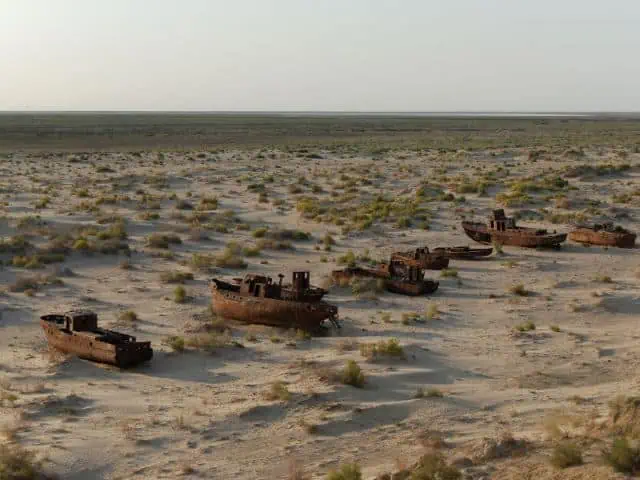
3.3 Pesticides and Their Impacts
Farmers rely on pesticides to protect cotton crops from pests and insects that can significantly reduce yields. The most common pests include the cotton bollworm and sucking pests like whiteflies and aphids (Haq et al., 2008; Bhusnar et al., 2021). Although high-yielding hybrid varieties and genetically modified (GM) crops, such as Bt cotton, were introduced to reduce the need for pesticides, they ironically contributed to an increased reliance on chemical pest control (Kannuri & Jadhav, 2018; Mancini et al., 2005). These GM crops remained vulnerable to other pests, prompting farmers to use pesticides as a precautionary measure (Kannuri & Jadhav, 2018; Mancini et al., 2005). Over time, the resistance of pests to pesticides has grown, necessitating more frequent or higher doses of chemical applications (Kannuri & Jadhav, 2018; Mancini et al., 2005).
a) Economic Burden
The high costs associated with pesticides contribute to financial strain on farmers, who often spend more on these chemicals than the economic benefits from cotton yields (Haq et al., 2008). In many developing countries, farmers tend to apply more pesticides than recommended, hoping to protect their crops, which reduces profitability (Haq et al., 2008; Bhusnar et al., 2021). This economic burden is further exacerbated by crop failures, pest resistance, and market conditions that do not always guarantee high returns (Haq et al., 2008; Bhusnar et al., 2021). For marginalized communities, the high cost of pesticides can lead to severe financial distress and indebtedness, a factor that has tragically contributed to the rise in farmer suicides (Kannuri & Jadhav, 2018).
b) Health Risks and Poisoning
Pesticides banned in developed nations are frequently used in poorer countries (Mancini et al., 2005). Consequently, studies have documented a high incidence of pesticide poisoning, with women particularly vulnerable due to their involvement in tasks such as mixing chemicals and refilling tanks (Mancini et al., 2005). Although training programs aimed at educating farmers on safe pesticide use have been implemented, they have not resulted in significant behavioral changes (Mancini et al., 2005).
The prohibitive cost, limited availability, and impracticality of protective equipment, especially in hot climates, have limited the widespread adoption of safety measures (Mancini et al., 2005). Low-income and marginalized farmers face even greater risks due to their precarious financial situations and limited access to safer alternatives or integrated pest management practices (Mancini et al., 2005).
The health implications of pesticide exposure are a serious concern. Acute exposure can result in skin irritations, respiratory problems, and poisoning (Bhusnar et al., 2021). In addition, prolonged exposure has been associated with more serious conditions, including chronic respiratory diseases and potential carcinogenic effects (Bhusnar et al., 2021).
c) Environmental Degradation and Water Contamination
Heavy rainfall, combined with poor drainage systems and excessive pesticide use, has led to the contamination of rivers and water supplies (Oral, 2019; Kennedy et al., 2002). The resulting pollution from chemical pesticides harms the environment and poses serious health risks to local communities, animals, and aquatic life that rely on these water sources (Oral, 2019). This pollution has also contributed to a decline in biodiversity, causing the disappearance of local bird species (Kannuri & Jadhav, 2018). The loss of beneficial insects and natural predators further disrupts ecological balance, leaving farming ecosystems more vulnerable to pest outbreaks (Kannuri & Jadhav, 2018).
Some pesticides have been found to bioaccumulate in fish, harming aquatic ecosystems and the people and animals who consume the contaminated fish (Kennedy et al., 2002). The quality of drinking water in affected communities has sharply declined, with an estimated 1.8 million deaths annually attributed to unsafe drinking water (Haq et al., 2008; Osiemo et al., 2019).
Excessive pesticide use also raises concerns about residue in cotton products, which can affect the quality and safety of agricultural exports (Bhusnar et al., 2021). Pesticide residues can enter the food chain through contaminated soil and water, creating serious public health risks (Bhusnar et al., 2021). Moreover, high levels of pesticide application have degraded soil fertility, limiting farmers’ ability to sustainably grow food or textile crops (Kannuri & Jadhav, 2018).
3.4 Impacts of Cotton Dyeing and Chemical Treatments
a) Dyeing
Developing countries often rely on traditional dyeing methods due to limited access to more advanced techniques like dye sublimation (Farrell, 2011). These dyeing processes require large amounts of treated water to ensure quality and color fastness (Uddin et al., 2023). Depending on the dye and process, dyeing 1 kilogram of cotton fabric can consume between 100 and 164 liters of water (Farrell, 2011; Uddin et al., 2023). This high level of water consumption contributes to significant treated water depletion, particularly in regions heavily populated by textile factories (Uddin et al., 2023).
The wastewater generated from the dyeing process contains a substantial amount of toxic chemicals, including heavy metals (Kant, 2012; Al-Tohamy et al., 2022). One study identified around 72 toxic chemicals in dye effluents, many of which are difficult to remove, resulting in severe water pollution and associated health risks (Kant, 2012). Despite this, efforts to treat this wastewater before its discharge into lakes, rivers, and streams are often inadequate or non-existent (Al-Tohamy et al., 2022).
b) Chemical Treatments
After the dyeing process, cotton typically undergoes various finishing treatments, such as softening, which are also highly water-intensive (Qian et al., 2021). Water usage for these finishing processes ranges from 30 to 60 liters per kilogram of fabric, depending on the specific chemical treatments applied (Qian et al., 2021). In addition to water, chemicals such as sodium hydroxide in pretreatment and dimethyl silicone oil in softening are commonly used (Qian et al., 2021). Although used in relatively small quantities, these chemicals have a substantial impact on human health and environmental ecosystems due to their persistence and resistance to natural degradation (Qian et al., 2021).
c) Impact on Workers
The equipment and processes required for dyeing and finishing expose workers to significant risks, including burns from hot machinery and toxic chemicals, inhalation of hazardous vapors, and prolonged skin contact with irritants (de Oliveira et al., 2023). Commonly used dyes and finishing agents often contain carcinogenic compounds like formaldehyde and heavy metals, which can lead to respiratory illnesses, skin diseases, and increased cancer risk (Kant, 2012). Inadequate use or unavailability of PPE amplifies these risks, heightening the likelihood of accidents and chronic health issues (de Oliveira et al., 2023).
d) Impact on Communities and Aquatic Ecosystems
In developing countries, where environmental laws are often unenforced, textile dyeing and finishing facilities frequently discharge untreated dyes and chemicals into nearby water bodies (Bick et al., 2018). These effluents contain hazardous substances, including heavy metals such as “lead, cadmium, and arsenic” (Kishor et al., 2021), which significantly harm local communities and ecosystems that depend on these water sources for drinking, agriculture, and fishing (Kishor et al., 2021). Prolonged exposure to these toxic chemicals has been linked to serious health conditions, including cancer, and neurological disorders (Kishor et al., 2021; Bick et al., 2018). In countries like China, approximately 1.84 billion cubic meters of untreated wastewater are released into the environment annually (Kishor et al., 2021).
Untreated dye effluents block sunlight in water bodies, hindering photosynthesis and threatening aquatic ecosystems (Kishor et al., 2021). Toxic compounds from dyes accumulate in fish, entering the food chain and posing significant risks to human health (Alsukaibi, 2022).
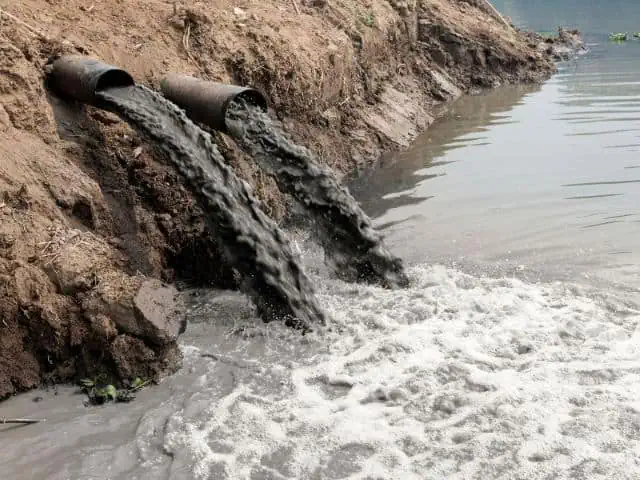
3.5 Diversion from Food Crops
The water used for growing cotton and supporting textile production often competes with resources needed for food crops, especially in regions already facing water shortages (Claudio, 2007). Diverting water to cotton farming increases food insecurity and limits local farming capacity (Claudio, 2007). In countries like Uzbekistan, India, and Pakistan, cotton is prioritized for export, which reduces the availability of water for other crops, leading to higher food prices and decreased supply (Claudio, 2007; Chapagain, 2006).
As water is reallocated from food crops to cotton, agricultural productivity for staple foods declines, particularly in developing countries where subsistence farming is vital (Chapagain, 2006). The growing use of water for non-food crops worsens food shortages, leading to increased hunger, malnutrition, and, in extreme cases, starvation (Bourne, 2009).
The problem is further intensified by climate change and growing competition for scarce resources, contributing to what experts describe as a “perpetual food crisis” (Bourne, 2009). Prioritizing water-intensive crops like cotton over food production diminishes the global capacity to meet rising food demands, particularly in regions already struggling with food insecurity (Bourne, 2009).
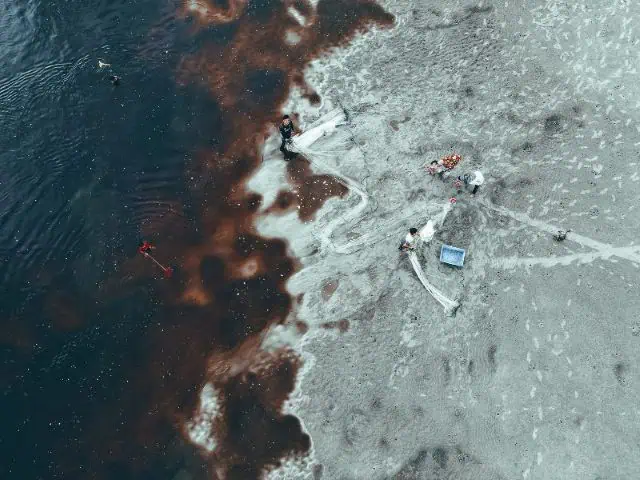
3.6 Global Scale of Water Usage
In 2015, the global fashion industry consumed approximately 79 billion cubic meters (or 79 trillion liters) of water (Zhao et al., 2021). As the fast fashion sector expands, water usage continues to rise. Additionally, many Western manufacturers continue to outsource production to countries like China, India, and Pakistan, further worsening water scarcity in regions already facing severe water stress (Zhao et al., 2021).
3.7 Textile Waste
The rapid growth of fast fashion, driven by accelerated production cycles and increased accessibility, has resulted in a substantial rise in textile waste. In 2018, the U.S. Environmental Protection Agency (EPA) reported that 11.3 million tons of textile waste were generated, marking a 560% increase since 1960 (U.S. Environmental Protection Agency, 2023).
Textile waste poses significant environmental challenges, particularly due to the lack of scalable global recycling solutions (Global Measure Inc., 2024). In Western countries, recycling is generally limited to garment repurposing, passing items down to friends and family, selling through second-hand markets, or donating to charity.
When charities cannot sell donated garments locally, they often sell and ship them to developing countries. However, power imbalances in this process allow firms in developed countries to capture most of the value by controlling collection, sorting, and export operations (Brooks, 2013). In contrast, traders and consumers in developing countries, particularly in Africa, operate in more vulnerable conditions with limited control over the quality or pricing of the goods they receive (Brooks, 2013). Often, fashion waste is sent under the pretext of donations, a practice referred to as “fashion waste colonialism” (Nkata, 2023). Approximately 40% of exported used clothing is of such poor quality that it is deemed unusable, ultimately ending up in landfills or incinerated upon arrival in developing countries (Dissanayake & Pal, 2023).
The influx of textile waste has exacerbated environmental degradation, particularly in developing countries that lack advanced waste management systems (Nkata, 2023). Textile waste is often burned, leading to increased air and water pollution as toxic fumes are released into the environment (Nkata, 2023; Lundberg & DeVoy, 2022). Used garments also end up in waterways, leaching dyes and finishing chemicals into water sources, negatively impacting local populations and aquatic life (Nkata, 2023; Lundberg & DeVoy, 2022).
In addition to environmental damage, this trade dynamic disrupts local economies. The global used clothing trade has expanded significantly, with exports from the European Union to African and Asian countries reaching 1.5 million tonnes in 2018 (Brooks & Simon, 2012). The surge in cheap imports has led to a sharp decline in domestic clothing production in countries such as Zambia, Nigeria, and Kenya, where local factories have shut down due to the competition for inexpensive second-hand garments (Brooks & Simon, 2012).
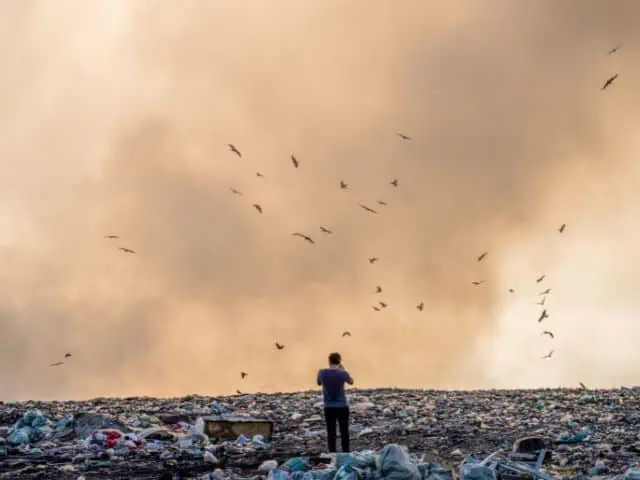
4.0 Conclusion
The destructive effects of the fast fashion industry on marginalized communities and the environment extend beyond the developing nations where most garment production takes place. As climate change accelerates and global water scarcity worsens—even in developed countries—the environmental damage caused by this unsustainable production model will eventually impact everyone. Polluted waterways, damaged ecosystems, and the growing frequency of extreme weather events are already beginning to reveal the real consequences of exceeding environmental limits. The idea that the negative impacts of overconsumption can simply be outsourced to poorer nations is a dangerous illusion.
Historically, the fashion industry was governed by guilds that regulated trade and ensured accountability, though these structures were far from inclusive. While globalization has dismantled such systems in favor of cheaper production and rapid distribution, it has also enabled the unchecked exploitation of labor and resources. This raises a critical question: As we face the interconnected challenges of climate change, inequality, and environmental degradation, what should our next steps look like? How do we establish ethical oversight in an increasingly globalized world? And more importantly, can we balance progress with sustainability, or has the pursuit of endless growth led us too far astray?

Deborah King
Deborah is a sustainable fashion expert located in Toronto, Canada. She’s an Industrial Engineer with a post-grad in Sustainable Fashion Production. She grew up on the tiny island of Tortola in the British Virgin Islands, and has been sewing her own clothing since the age of 10. She founded Global Measure to help authentically sustainable and ethical fashion businesses stand out from the greenwashing noise through third-party certification.
References:
Ahmad, Y. S., Hamid, A., Saif, S., & Mehmood, A. (2020). Assessment of health and safety risks in a textile industry [Research Report]. Journal of Natural and Applied Sciences Pakistan, 2(1), 350-369. Retrieved Sept 16, 2024, from https://jnasp.kinnaird.edu.pk/wp-content/uploads/2024/08/11.-Yusra-Saleem-JNASP-350-369.pdf
Akhter, S., Salahuddin, A. F., Iqbal, M., Malek, A. B. M. A., & Jahan, N. N. (June, 2010). Health And Occupational Safety for Female Workforce of Garment Industries in Bangladesh [Research Report]. Journal of Mechanical Engineering, 41(1), p65-72. Retrieved Sept 16, 2024, from https://doi.org/10.3329/jme.v41i1.5364
Alsukaibi, A. K. D. (September, 2022). Various approaches for the detoxification of toxic dyes in wastewater [Research Report]. Processes, 10(1968), 1-27. Retrieved Sept 16, 2024, from https://doi.org/10.3390/pr10101968
Al-Tohamy, R., Ali, S. S., Li, F., Okasha, K. M., Mahmoud, Y. A.-G., Elsamahy, T., Jiao, H., Fu, Y., & Sun, J. (February, 2022). A critical review on the treatment of dye-containing wastewater: Ecotoxicological and health concerns of textile dyes and possible remediation approaches for environmental safety [Research Report]. Ecotoxicology and Environmental Safety, 231, 113160. Retrieved Sept 16, 2024, from https://doi.org/10.1016/j.ecoenv.2021.113160
Anner, M., & Dutta, M. (November, 2019). Sourcing dynamics, workers’ rights, and inequality in garment global supply chains in India. Center for Global Workers’ Rights, Pennsylvania State University [Research Report]. Retrieved Sept 20, 2024, from https://ler.la.psu.edu/wp-content/uploads/sites/4/2021/11/CGWR-Garment-Sourcing-and-Workers-Rights-in-India-Nov.-15-2019.pdf
Aris (June, 2024). Cider: A Story of Fast Fashion, Gen Z, and the Quest to Become the Next SHEIN. Panda!Yoo. Retrieved Sept 20, 2024, from https://pandayoo.com/post/cider-a-story-of-fast-fashion-gen-z-and-the-quest-to-become-the-next-shein/
Asare, T. O., Ibrahim, A. F., & Nyarko, M. O. (March, 2019). Occupational health and safety status of workers in the garment industry in Ghana [Research Report]. Institute of Textiles & Fashion Professionals Ghana. Fashion and Textiles Review, 1(1), p37-50. Retrieved Sept 16, 2024, from https://doi.org/10.35738/ftr.20190101.4
Bhusnar, J. R.,Shende, N. V., & Koshti, N. R. (July, 2021). Technical efficiency of pesticide use in cotton cultivation in Yavatmal district [Research Report]. Asian Journal of Extension Education, 39, p143-164. Retrieved Sept 16, 2024, from https://ajeeakola.in/pdf/Journal-Volume-39-2021.pdf
Bick, R., Halsey, E., & Ekenga, C. C. (December, 2018). The global environmental injustice of fast fashion [Research Report]. Environmental Health, 17, 92. Retrieved Sept 16, 2024, from https://doi.org/10.1186/s12940-018-0433-7
Bland, A., & Campbell D. (June, 2020). Some Leicester factories stayed open and forced staff to come in. The Guardian. Retrieved Sept 20, 2024, from https://www.theguardian.com/uk-news/2020/jun/30/some-leicester-factories-stayed-open-and-forced-staff-to-come-in
Bourne, J. K., Jr. (June, 2009). The global food crisis: The end of plenty [Research Report]. National Geographic Magazine. Retrieved Sept 16, 2024, from https://www.fusd1.org/cms/lib03/AZ01001113/Centricity/Domain/1049/The%20Global%20Food%20Crisis_The%20End%20of%20Plenty.pdf
Brooks, A. (January, 2013). Stretching global production networks: The international second-hand clothing trade [Research Report]. Geoforum, 44, 10-22. Retrieved Sept 16, 2024, from https://doi.org/10.1016/j.geoforum.2012.06.004
Brooks, A., & Simon, D. (September, 2012). Unravelling the relationships between used‐clothing imports and the decline of African clothing industries. Development and Change, 43(6), 1265-1290. Retrieved Sept 16, 2024, from https://doi.org/10.1111/j.1467-7660.2012.01797.x
Bryant, K., & Joudo, B. (2021). Are we leaving no-one behind? How gaps in modern slavery programmes allow forced labour among adolescent girls in the garment and textile industries [Research Report]. Archives of Criminology, 43(1), 19-46. Retrieved Sept 16, 2024, from https://doi.org/10.7420/AK2021.08
Chan, M. K. (November, 2013). Contract Labour in Global Garment Supply Chains: Key Characteristics and Recent Trends. Women in Informal Employment: Globalizing and Organizing (WIEGO) [Report]. Retrieved Sept 20, 2024, from https://www.wiego.org/sites/default/files/publications/files/Chan_Contract_Labour_Report_final_2013.pdf
Chapagain, A. K., Hoekstra, A. Y., Savenije, H. H. G., & Gautam, R. (November, 2006). The water footprint of cotton consumption: An assessment of the impact of worldwide consumption of cotton products on the water resources in the cotton-producing countries [Research Report]. Ecological Economics, 60(1), 186–203. Retrieved Sept 16, 2024, from https://doi.org/10.1016/j.ecolecon.2005.11.027
Claudio, L. (September, 2007). Waste couture: Environmental impact of the clothing industry [Research Report]. Environmental Health Perspectives, 115(9), A448-A454. Retrieved Sept 16, 2024, from https://doi.org/10.1289/ehp.115-a449
Clean Clothes Campaign. (n.d.). Gender: Women workers mistreated. Retrieved Sept 20, 2024, from https://cleanclothes.org/issues/gender
Clean Clothes Campaign. (November, 2022). A decade after Bangladesh’s most deadly factory fires, brands like Walmart still ignore workers’ safety. Retrieved Sept 16, 2024, from https://cleanclothes.org/news/2022/a-decade-after-bangladeshs-most-deadly-factory-fires-brands-like-walmart-still-ignore-workers-safety
Crimestoppers UK. (n.d.). Modern slavery. Retrieved Sept 16, 2024, from https://crimestoppers-uk.org/keeping-safe/community-family/modern-slavery
Curry, D. (May, 2024). ASOS Revenue and Usage Statistics (2024). Business of Apps. Retrieved Sept 20, 2024, from https://www.businessofapps.com/data/asos-statistics/
Curry, D. (May, 2024). Shein Revenue and Usage Statistics (2024). Business of Apps. Retrieved Sept 20, 2024, from https://www.businessofapps.com/data/shein-statistics/
de Oliveira, C. R. S., de Aguiar, C. R. L., Missner, M. E. P., Aragão, F. V., da Silva Júnior, A. H., & Mapossa, A. B. (December, 2023). A comprehensive guide to textile process laboratories: Risks, hazards, preservation care, and safety protocol [Research Report]. Laboratories, 1(1), 1–33. Retrieved Sept 16, 2024, from https://doi.org/10.3390/laboratories1010001
Dissanayake, K., & Pal, R. (March, 2023). Sustainability dichotomies of used clothes supply chains: A critical review of key concerns and strategic resources [Research Report]. The International Journal of Logistics Management, 34(7), 75-97. Retrieved Sept 16, 2024, from https://doi.org/10.1108/IJLM-10-2022-0410
Farrell, M. J. (December, 2011). Sustainable cotton dyeing (Doctoral dissertation) [Research Report]. North Carolina State University. Retrieved Sept 16, 2024, from http://www.lib.ncsu.edu/resolver/1840.16/7452
FashionUnited. (n.d.). Global fashion industry statistics. Retrieved Sept 20, 2024, from https://fashionunited.com/global-fashion-industry-statistics
Foote, L. J. (January, 1994). The vulnerable and exploitable immigrant workforce and the need for strengthening worker protective legislation [Research Report]. The Yale Law Journal, 103(8), 2179-2202. Retrieved Sept 16, 2024, from http://hdl.handle.net/20.500.13051/8841
Forbes. (n.d.). PROFILE: Stefan Persson. Retrieved Sept 20, 2024, from https://www.forbes.com/profile/stefan-persson/
Ford, R. T. (2021). Dress codes: How the laws of fashion made history. Simon & Schuster. ISBN 978-1-5011-8008-8
Gaybullaev, B., Chen, S.-C., & Mahmudov, T. (2009). An ecological disaster of the Aral Sea [Research Report]. Journal of Soil and Water Conservation, 41(3), p325-338. Retrieved Sept 16, 2024, from
https://swcdis.nchu.edu.tw/AllDataPos/JournalPos/%E7%B7%A8%E8%99%9F47/%E7%AC%AC3%E6%9C%9F/41-3-7.pdf
Global Measure Inc. (April, 2022). Have We Learned from the Rana Plaza Disaster? Retrieved Sept 16, 2024, from https://globalmeasure.org/rana-plaza-disaster/
Global Measure Inc. (August, 2024). Key requirements for EPR success in the Canadian fashion industry. Retrieved Sept 16, 2024, from https://globalmeasure.org/epr-4/
Graham, A. (2020). How modern celebrity culture is promoting consumerism more than ever. Fizzy Mag. Retrieved Sept 20, 2024, from https://fizzymag.com/articles/how-modern-celebrity-culture-is-promoting-consumerism-more-than-ever
Grybauskaite, D. (May, 2024). Celebrity influence and its impact on fashion trends. The Circular. Retrieved Sept 20, 2024, from https://thecircular.org/celebrity-influence-and-its-impact-on-fashion-trends/
H&M Group (January, 2024). Press release: H & M Hennes & Mauritz AB Full-year report. Retrieved Sept 20, 2024, from https://hmgroup.com/news/h-m-hennes-mauritz-ab-full-year-report-16/
Haq, Q., Ali, T., Ahmad, M., & Nosheen, F. (2008). An analysis of pesticide usage by cotton growers: A case study of District Multan, Punjab-Pakistan [Research Report]. Pakistan Journal of Agricultural Sciences, 45(1), p133-137. Retrieved Sept 16, 2024, from https://api.pakjas.com.pk/downloadPaper/241.pdf
Hayes, A. (June, 2024). Fast Fashion: How It Impacts Retail Manufacturing. Investopedia. Retrieved Sept 20, 2024, from https://www.investopedia.com/terms/f/fast-fashion.asp
Helm, M. (September, 2024). Beneath the seams: The human toll of fast fashion. Earth Day Organization. Retrieved Sept 20, 2024, from https://www.earthday.org/beneath-the-seams-the-human-toll-of-fast-fashion/
Hunter, A. (May, 2020). Sewing revolution: A story stitched in history. Greene Publishing. Retrieved Sept 20, 2024, from https://www.greenepublishing.com/sewing-revolution-a-story-stitched-in-history/
International Labour Organization. (n.d.). What is forced labour? Retrieved Sept 16, 2024, from https://www.ilo.org/topics/forced-labour-modern-slavery-and-trafficking-persons/what-forced-labour
James, M. A. (May, 2022). Child labor in your closet: Efficacy of disclosure legislation and a new way forward to fight child labor in fast fashion supply chains [Research Report]. The Journal of Gender, Race & Justice, University of Iowa, 25, 246-278. Retrieved Sept 16, 2024, from https://jgrj.law.uiowa.edu/online-edition/volume-25-issue/child-labor-in-your-closet-efficacy-of-disclosure-legislation-and-a-new-way-forward-to-fight-child-labor-in-fast-fashion-supply-chains
Jans, Y., von Bloh, W., Schaphoff, S., & Müller, C. (April, 2021). Global cotton production under climate change: Implications for yield and water consumption [Research Report]. Hydrology and Earth System Sciences, 25(4), p2027-2044. Retrieved Sept 16, 2024, from https://doi.org/10.5194/hess-25-2027-2021
Kannuri, N. K., & Jadhav, S. (June, 2018). Generating toxic landscapes: Impact on well-being of cotton farmers in Telangana, India [Research Report]. Anthropology & Medicine, 25(2), p121-140. Retrieved Sept 16, 2024, from https://doi.org/10.1080/13648470.2017.1317398
Kant, R. (January, 2012). Textile dyeing industry: An environmental hazard [Research Report]. Natural Science, 4(1), p22-26. Retrieved Sept 16, 2024, from https://doi.org/10.4236/ns.2012.41004
Kativa, H. S. (October, 2016). Synthetic threads. Science History Institute Museum & Library. Retrieved Sept 20, 2024, from https://www.sciencehistory.org/stories/magazine/synthetic-threads/
Kennedy, I. R., Sánchez-Bayo, F., & Caldwell, R. A. (January, 2002). Cotton pesticides in perspective: A discussion paper on pesticide management for the cotton industry (2nd ed.) [Research Report]. Australian Cotton Cooperative Research Centre, University of Sydney. Retrieved Sept 16, 2024, from https://www.researchgate.net/publication/265141052_Cotton_Pesticides_in_Perspective
Kent, S. (September, 2023). A ‘Climate of Fear’ in Fashion’s Supply Chains. Business of Fashion. Retrieved Sept 16, 2024, from https://www.businessoffashion.com/articles/sustainability/union-busting-fashion-supply-chain-labour-abuse-bangladesh-killing/
Ketteler, J. (2010, August). Sewing through the years. Wonders & Marvels. Retrieved Sept 20, 2024, from https://www.wondersandmarvels.com/2010/08/sewing-through-the-years.html
Kishor, R., Purchase, D., Saratale, G. D., Saratale, R. G., Ferreira, L. F. R., Bilal, M., Chandra, R., & Bharagava, R. N. (April, 2021). Ecotoxicological and health concerns of persistent coloring pollutants of textile industry wastewater and treatment approaches for environmental safety [Research Report]. Journal of Environmental Chemical Engineering, 9(1), 105012. Retrieved Sept 16, 2024, from https://doi.org/10.1016/j.jece.2020.105012
Krick, J. (October, 2004). Charles Frederick Worth (1825–1895) and the House of Worth. The Metropolitan Museum of Art. Retrieved Sept 20, 2024, from https://www.metmuseum.org/toah/hd/wrth/hd_wrth.htm
Kyritsis, P., LeBaron, G., & Nova, S. (November, 2020). Hunger in the apparel supply chain: Survey findings on workers’ access to nutrition during Covid-19. Worker Rights Consortium [Research Report]. Retrieved Sept 20, 2024, from https://www.workersrights.org/wp-content/uploads/2020/11/Hunger-in-the-Apparel-Supply-Chain.pdf
Lau, Y.-Y., & Chan, E. M. H. (2021). Exploratory Study on Preventive Measures To Prevent Child Labour Exploitation in Belt And Road Countries From The Perspective of The Fashion Industry [Research Report]. International Journal of Innovation, Creativity and Change, 15(6), p462-491. Retrieved Sept 16, 2024, from https://www.ijicc.net/images/Vol_15/Iss_6/15613_Lau_2021_E1_R.pdf
LeBaron, G., Howard, N., Thibos, C., & Kyritsis, P. (2018). Confronting root causes: Forced labour in global supply chains. The Sheffield Political Economy Research Institute (SPERI), University of Sheffield [Research Report]. Retrieved Sept 16, 2024, from https://core.ac.uk/download/pdf/145637779.pdf
Ludmer, G., Schuffer, N., Schteingart, D., & Isaak, P. (June, 2023). Employment in the textile and apparel industry. Retrieved Sept 20, 2024, from https://fund.ar/en/publicacion/employment-in-the-textile-apparel-industry/
Lundberg, D., & DeVoy, J. (September, 2022). The aftermath of fast fashion: How discarded clothes impact public health and the environment. Boston University School of Public Health. Retrieved Sept 16, 2024, from https://www.bu.edu/sph/news/articles/2022/the-aftermath-of-fast-fashion-how-discarded-clothes-impact-public-health-and-the-environment/
Malik, N., Maan, A. A., Pasha, T. S., Akhtar, S., & Ali, T. (January, 2010). Role of hazard control measures in occupational health and safety in the textile industry of Pakistan [Research Report]. Pakistan Journal of Agricultural Sciences, 47(1), 72-76. Retrieved Sept 16, 2024, from https://www.researchgate.net/publication/285488423_Role_of_hazard_control_measures_in_occupational_health_and_safety_in_the_textile_industry_of_Pakistan
Mancini, F., van Bruggen, A. H. C., Jiggins, J. L. S., Ambatipudi, A. C., & Murphy, H. (July, 2005). Acute pesticide poisoning among female and male cotton growers in India [Research Report]. International Journal of Occupational and Environmental Health, 11(3), 221-232. Retrieved Sept 16, 2024, from https://doi.org/10.1179/107735205800246064
McFall-Johnsen, M. (January, 2020). These facts show how unsustainable the fashion industry is. World Economic Forum. Retrieved Sept 20, 2024, from https://www.weforum.org/agenda/2020/01/fashion-industry-carbon-unsustainable-environment-pollution/
McLaughlin, T. (September, 2024). The Mysterious, Meteoric Rise of Shein: A murky founding story, a shadowy CEO, and a staggering takeover of American retail. The Atlantic. Retrieved Sept 20, 2024, from https://www.theatlantic.com/international/archive/2024/09/shein-ceo-chris-xu-fast-fashion/679709/
Murphy, L. T., et al. (2021). Laundering cotton: How Xinjiang cotton is obscured in international supply chains [Research Report]. Sheffield Hallam University Helena Kennedy Centre for International Justice. Retrieved Sept 16, 2024, from https://www.researchgate.net/publication/366812676_LAUNDERING_COTTON_HOW_XINJIANG_COTTON_IS_OBSCURED_IN_INTERNATIONAL_SUPPLY_CHAINS
National Council of the Maquiladora and Manufacturing Export Industry (INDEX) (n.d.). History of manufacturing in Mexico. Retrieved Sept 20, 2024, from https://index.org.mx/history/
National WWII Museum. (n.d.). Research starters: Women in World War II. Retrieved Sept 20, 2024, from https://www.nationalww2museum.org/students-teachers/student-resources/research-starters/research-starters-women-world-war-ii
Nkatha, K. (September, 2023). How fast fashion is fuelling the fashion waste crisis in Africa. Greenpeace. Retrieved Sept 16, 2024, from https://www.greenpeace.org/africa/en/blog/54589/how-fast-fashion-is-fuelling-the-fashion-waste-crisis-in-africa/
Oral, E. (September, 2019). Sustainability challenges of fast fashion: Environmental and social impacts of cotton growing and the ready-made garment industry in Turkey [Research Report]. Yuridika, 34(3), 443-466. Retrieved Sept 16, 2024, from https://doi.org/10.20473/ydk.v34i3.14937
Osiemo, M. M., Ogendi, G. M., M’Erimba C. (March 2019). Microbial Quality of Drinking Water and Prevalence of Water-Related Diseases in Marigat Urban Centre, Kenya [Research Report]. Environ Health Insights. Retrieved Sept 16, 2024, from https://doi.org/10.1177/1178630219836988
Padder, F. A., & Bashir, A. (March, 2023). Scarcity of water in the twenty-first century: Problems and potential remedies [Research Report]. Medalion Journal: Medical Research, Nursing, Health and Midwife Participation, 4(1), 1–5. Retrieved Sept 16, 2024, from https://medalionjournal.com/index.php/go/article/view/66
Paramasivam, P., Raghavan, P. M., Srinivasan, P. D., & Kumar, G. A. (December, 2010). Knowledge, attitude, and practice of dyeing and printing workers [Research Report]. Indian Journal of Community Medicine, 35(4), p498-501. Retrieved Sept 16, 2024, from https://doi.org/10.4103/0970-0218.74358
Precision Business Insights. (n.d.). Fast Fashion Market Size, Share, Growth, Trends, and Global Industry Analysis: By Product Type (Apparel, Accessories, Footwear), By Distribution Channel (Online, Offline), Region. Retrieved Sept 20, 2024, from https://www.precisionbusinessinsights.com/market-reports/fast-fashion-market
PressFarm. (June, 2024). Amancio Ortega net worth: Zara founder’s fortune. Retrieved Sept 20, 2024, from https://press.farm/amancio-ortega-net-worth-zara-founders-fortune/
Qian, W., Qiu, X., Guo, Y., Ji, X., Li, Y., & Wang, L. (2021). Chemical footprint of the wet processing of cotton fabric [Research Report]. Fibres & Textiles in Eastern Europe, 29(4), 100-104. Retrieved Sept 16, 2024, from https://bibliotekanauki.pl/articles/1857664
Radhakrishnan, S. (May, 2015). Social impacts of the clothing and fashion industry [Research Report]. In S. S. Muthu (Ed.), Handbook of Sustainable Apparel Production (pp. 207-225). CRC Press. Retrieved Sept 16, 2024, from https://doi.org/10.1201/b18428-13
Raigrodski, D. (November, 2016). Creative Capitalism And Human Trafficking: A Business Approach To Eliminate Forced Labor And Human Trafficking From Global Supply Chains [Research Report]. William & Mary Business Law Review, 8(1), p71-136. Retrieved Sept 16, 2024, from https://scholarship.law.wm.edu/wmblr/vol8/iss1/3
Remy, N., Speelman, E., and Swartz, S. (October, 2016). Style that’s sustainable: A new fast-fashion formula. McKinsey & Company. Retrieved Sept 20, 2024, from https://www.mckinsey.com/capabilities/sustainability/our-insights/style-thats-sustainable-a-new-fast-fashion-formula
Shah, D. (August, 2024). How Celebrities Shape Fashion: Influence, Diversity, and the Ever-Evolving Trends. Fibre2Fashion. Retrieved Sept 20, 2024, from https://www.fibre2fashion.com/industry-article/10113/how-celebrities-shape-fashion-influence-diversity-and-the-ever-evolving-trends
Sierra, B. (February, 2023). The psychology of fast fashion: Why conversation about fast fashion evokes such strong emotions in us. The Sustainable Fashion Forum. Retrieved Sept 20, 2024, from https://www.thesustainablefashionforum.com/pages/the-psychology-of-fast-fashion-exploring-the-complex-emotions-fast-fashion-evokes-in-consumers
Simmons, M. E. (March, 2020). Human rights in the fashion industry: Discovering the origins of exploitation along the supply chain [Research Report] (Master’s dissertation, Glasgow Caledonian New York College). Retrieved Sept 16, 2024, from https://static1.squarespace.com/static/5ef4f0930d6ad7677611d91e/t/5efe3d9b842cc9218e8ea0f6/1593720223578/Megan+Simmons+-+Final+Dissertation+website+copy.pdf
Statista. (n.d.). Inditex Group’s sales worldwide from 2004 to 2023. Retrieved Sept 20, 2024, from https://www.statista.com/statistics/268817/sales-of-the-inditex-group-worldwide/
Statistics Canada. (n.d.). It’s a wild world: Changing labour market conditions after the postwar boom. Retrieved Sept 20, 2024, from https://www150.statcan.gc.ca/n1/pub/11-008-x/2006002/4097654-eng.htm
Tager, S. (April, 2016). Women in the global clothing and textile industry (Undergraduate honors thesis). Duke University. Retrieved Sept 20, 2024, from https://dukespace.lib.duke.edu/server/api/core/bitstreams/a4b7b671-630d-4871-9149-cd948032a109/content
Uddin, M. A., Begum, M. S., Ashraf, M., Azad, A. K., Adhikary, A. C., & Hossain, M. S. (July, 2023). Water and chemical consumption in the textile processing industry of Bangladesh [Research Report]. PLOS Sustainability and Transformation, 2(7), e0000072. Retrieved Sept 16, 2024, from https://doi.org/10.1371/journal.pstr.0000072
Ünlütürk, Ç., & Öngel, S. (2023). For fair fashion: Improving due diligence, wages, and gender equity in the Turkish garment sector. Fair Wear Foundation Consortium [Research Report]. Retrieved Sept 20, 2024, from https://wp.fairwear.org/wp-content/uploads/2023/07/FW-RVO-For-fair-fashion_garment-workers.pdf
U.S. Environmental Protection Agency. (November, 2023). Facts and Figures about Materials, Waste and Recycling. Textiles: Material-specific data. Retrieved Sept 16, 2024, from https://www.epa.gov/facts-and-figures-about-materials-waste-and-recycling/textiles-material-specific-data
van Klaveren, M., & Tijdens, K. (August, 2018). Mapping the global garment supply chain. WageIndicator Foundation [Research Report]. Retrieved Sept 20, 2024, from https://wageindicator.org/documents/publicationslist/publications-2018/2018-garment-wageindicator.pdf
Walk Free. (n.d.). Global Slavery Index: Stitched with slavery in the seams. Retrieved Sept 16, 2024, from https://www.walkfree.org/global-slavery-index/findings/spotlights/stitched-with-slavery-in-the-seams/
Wiersma, E. (April, 2018). Fire Safety in The Ready-Made Garment Industry in Bangladesh, Five Years After Rana Plaza [Research Report]. Conference paper presented at Safety in the Garment Industry, Dhaka. Retrieved Sept 16, 2024, from https://www.researchgate.net/publication/326175338
Wyman, D. (December, 2006). Trade liberalization and the Canadian clothing market. Canadian Economic Observer, 19(12). Retrieved Sept 20, 2024, from Statistics Canada. https://www150.statcan.gc.ca/n1/pub/11-010-x/01206/9545-eng.htm
Zhao, M., Zhou, Y., Meng, J., Zheng, H., Cai, Y., Shan, Y., Guan, D., & Yang, Z. (June, 2021). Virtual carbon and water flows embodied in global fashion trade: A case study of denim products [Research Report]. Journal of Cleaner Production, 303, 127080. Retrieved Sept 16, 2024, from https://doi.org/10.1016/j.jclepro.2021.127080
Zion Market Research. (n.d.). Fast Fashion Market Size, Share, Industry Analysis, Trends, Growth, Forecasts, 2030. Retrieved Sept 20, 2024, from https://www.zionmarketresearch.com/report/fast-fashion-market

